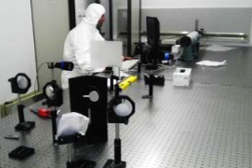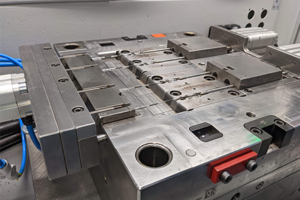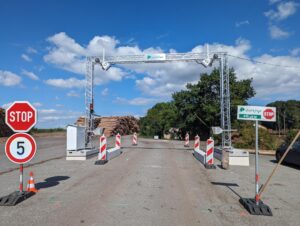For the purpose of the ELI project, a demonstrator of mirror system for beam transfer, that is placed in vacuum, was designed and fabricated. The project included the design of optics, functional verification, design of the opto-mechanics and vacuum system, optics fabrication, opto-mechanics fabrication, vacuum system fabrication, and optical testing.
Telescope demonstrator for femtosecond laser beam transmission
As a part of the ELI project was needed to transfer the femtosecond laser beams from the “laser” itself to the experimental halls, which included several challenges:
- It was necessary to transfer not only the intensity profile, but also the waveform (i.e. the divergence of the beams) has to be transferred over a distance of 20m.
- It was not possible to use a classical 4f lens arrangement, as the pulse is too short and the lenses would cause the pulse to broaden in time, and also too intense, and thus some of the energy absorbed in the lenses would be problematic.
- In addition, it was necessary to conduct the beam under vacuum (at least 1e-5 mbar, better at the focal points).
- The transmitted beam had to be a square shape with a side of 210 mm.
Therefore, a solution using a suitable combination of mirrors instead of lenses has been proposed. The aim of the project was then to design the specific arrangement, mounting of the mirrors, optical benches, and vacuum chambers, and to fabricate and test these chambers and mirrors in visible light.

The project ultimately consisted of several phases, which can be summarised as follows:
- Tests of the proposed optical layout were carried out on a scale model on an optical table. This verified the principle functionality, and we gained experience with the sensitivity of the proposed system and with its sensitivity not the accuracy of the setup.
- Subsequently, the mechanics, i.e., the methods of mounting the mirrors, as well as the vacuum chamber, its beam, the beams of the optical bench, etc., were designed.
- Subsequently, a set of chambers, mechanics and optics for a single telescope (i.e. two chambers) was fabricated first. Vacuum and optical tests were carried out on this first telescope.
- Based on the experience with the first set, the basis for the production of the second set was modified.
Since the chambers of the final telescope will be mounted on the ceiling of the ELI building, they were made of aluminum alloy, which reduced the weight of the chambers (stainless steel would have about 50% more weight for the same strength) and despite the 1.2 meter inner diameter of the chambers, they can still be handled manually. The optical chambers were mounted on beams that allowed for attachment to the ceiling (or floor in the case of the tests), plus fine adjustment of its position after attachment, in 6 axes. Finally, an optical bench was created inside the optical chamber, which is attached to the ceiling independently of the chamber (it is only in contact with the chamber through the bellows) to minimize the transmission of vibrations of the vacuum system to the optical bench. Also, the optical bench allows for fine manipulation and position adjustment in 6 axes once attached. Custom mirror holders are then placed on the optical bench to allow motorized rotation of the mirrors along the 2 axes, plus additional manual alignment.
Optical tests were performed with beam diameters of approximately 80 mm and 200 mm. Intensity transfer tests were performed using several siemens stars (commercial and custom made 200 mm diameter). Wavefront measurements were performed using a variation of the Hartmann test.
Other Case Studies




